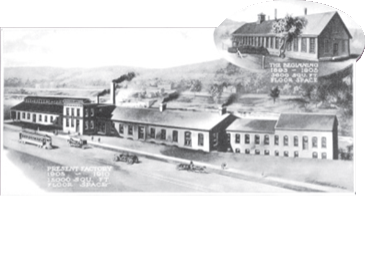Carbide Tools
View Printable PDF - Carbide Tool Guide
Ver PDF Imprimible - Guía para Herramientas de Carbide
An Introduction to Carbide Hand Tools
Trow & Holden strongly believes the first step in providing excellent customer service is delivering the highest quality product. To do so, we remain committed to the materials, innovation, and craftsmanship required to manufacture long-lasting, reliable stoneworking tools with durable carbide blades.
The information below outlines the basic best practices, as well as the proper usage and maintenance, required the get the most out of your carbide-tipped stoneworking tools. Choosing the right tool will help prevent breakage, achieve the best results, and make your work more efficient — saving time and money. Please take a few minutes to review this information before putting your Trow & Holden tools to work.
Basic Tool Functions
Start by taking into account the type of tool that best fits the task at hand. Hand tools will fall into three basic categories of function, which we have listed below. You can see all of these tools in action on the videos section of the website.
- Splitting
Used to score and split off the largest segments of stone, Hand Tracers are held vertically while being moved back and forth across the stone to score a split line. This process is continued until the stone has split. - Trimming & Squaring
For trimming, squaring, or “rock-facing,” Hand Sets are used to define the edge of the stone. Tip the Hand Set slightly back onto its edge and strike along your trimming line. To achieve optimal material removal on a variety of stones and surfaces, there are variations of the Hand Set, such as the Offset, Mason’s Chipper, and Rocko. - Chiseling & Pointing
Used for roughing out or removing high spots, Hand Points & Hand Chisels are ideal for fast, aggressive material removal and for preparing the stone’s surface for the use of wider carbide-tipped tools. - Stoneworking Hammers
Trow & Holden manufactures a wide range of carbide-tipped stoneworking hammers intended to enhance or combine the basic tool functions listed above. While we always recommend maintaining a basic set of versatile hand tools, stoneworking hammers can be an excellent way to shape stone faster and with less effort. A more detailed overview of our full range of hammers can be found here.
Proper Size Selection
The right size tool will feel comfortable in your hand, allow complete contact of blade to the stone, and be of a width and weight that provides controlled material removal. Don’t forget to pay attention to stock sizes (i.e. handle thickness) in addition to blade widths, and keep in mind that a larger, heavier tool does not always increase productivity. This is particularly true when working with soft or thin stone.
Use & Care of Carbide Tools
Carbide maintains its shape under heavy usage because it is very hard. For this reason, carbide can actually crack or break if not handled correctly. Carbide tools can save a lot of time and be an excellent investment when treated properly. Here are some guidelines for use that will help you get years of excellent performance.
Note the shape of the carbide when the tool is new. It is important to maintain the same “like new” shape and basic tool characteristics over the lifetime of the tool, which includes keeping a slight bevel or chamfer on all the edges and corners of the tool’s carbide tip. Carbide that is left too sharp can be more susceptible to chipping or cracking.
During use, make sure your carbide blade makes even contact with the surface of the stone. And, particularly with new tools, make sure your first strike is a light hit. This will help “set” the tool and put the blade in full contact with the stone.
If the tool has been in use, check the cutting edge of your carbide for wear. While carbide-tipped tools should be kept slightly beveled, excessively rounded edges require harder striking to be effective and this will lead to breakage.
Check the striking end of your tool as well. Because the hammer and chisel cannot be the same hardness, your chisel is a little softer and will begin to show wear after some use. Grind the struck end of any tool that begins to show signs of work hardening, flaking, spawling, or any distortion in shape. (i.e. before it “mushrooms.") Excessive mushrooming and work hardening will lead to cracks in the striking surface, which can present a serious safety hazard if neglected. Take time to re-dress your tools regularly.
Redressing Carbide
- Use a bench grinder with an 80-grit silicon carbide wheel (or “green wheel”) to sharpen carbide, or use diamond pads (as seen in Trow & Holden's Swivel Sharpening System)
- Return carbide to its original shape; be mindful of symmetry and straightness of cutting edge(s)
- Lightly "break" or bevel sharp edges and corners before returning to use
- Always allow carbide to air-cool; never dip it in water or oil to cool it
Redressing Struck Heads of Tools
- Use a bench grinder fitted with a high quality aluminum oxide wheel, or a belt grinder, to remove work-hardened or deformed steel and to reestablish the bevel and crown of the struck head
- Avoid overheating the steel, which is indicated by discoloration and will result in softening the head of the tool
- Quench the steel head of the tool in water often while grinding to keep the steel cool
- A finer grit abrasive should be used to finish buffing the struck head of the tool, leaving it free of coarse scoring
Trow & Holden is happy to provide tool grinding and maintenance services. If you have a chisel that needs maintenance, please give us a call so that we can provide guidance and information regarding any associated costs.
Common Causes of Carbide Breakage
These are the most common causes of carbide tool breakage that would not be covered by our guarantee:
- Striking a carbide tool without properly setting the blade, or when wobbling on a high spot, causing a break or hairline crack due to uneven contact with the stone
- Using the corner of a carbide blade as a Point, depriving it of proper support when struck
- Failure to regularly regrind and maintain carbide in its “as new” shape, leaving an excessively rounded edge and resulting in a broken weld
- Re-grinding carbide to a very sharp edge without properly beveling edges before use
- Re-grinding a tool in a way that significantly changes the shape of the carbide or removes the steel supporting the carbide
- Inserting a carbide blade into a crack or saw mark in the stone, or using it as a wedge for splitting
- Using any carbide or steel tool as a lever
- Using a toothed chisel on granite or other very hard stone
- Using a carbide hammer to strike a hand tool, other steel object, or to be struck by another hammer
With proper care, carbide tools will give you many years of use and save time in the process. If you have a carbide chisel that is broken, please call us so that we can help determine the best course of action for a repair or replacement.







